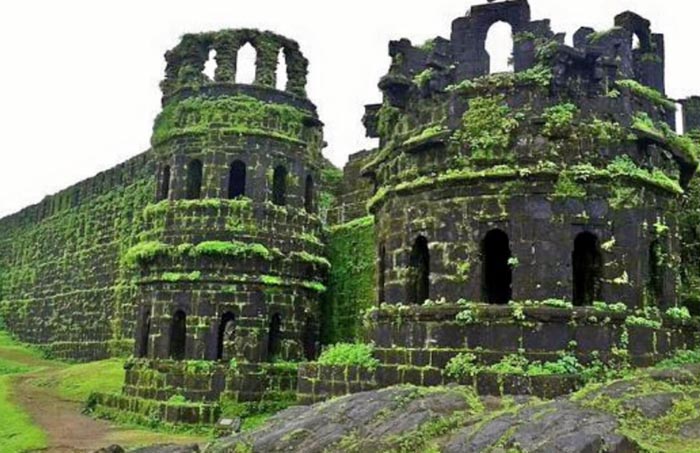Raigad Fort

Information on Raigad Fort (Raigad, Maharashtra) - History & Architecture
Raigad Fort is 984 years old hill fortress beautifully located in the northern belts of the Western Ghats. This is the great and strong fort for the Maratha Empire. The great Chatrapathi Shivaji Maharaj was laid to rest here after his death. This is a very important fort in the Marat wad kingdom. It is located in the Mahad City, Raighad District of Maharashtra State in India.
Raigad Fort Architecture
Raigad Fort was first built in the traditional residential fort type. It was later modified to a defensive fort in the 17the century by Shivaji Maharaja and was found in the architectural style of the medieval period forts found in India. This fortress is built at an altitude of 820 meters of the Shyadri Mountain Ranges in Maharashtra. This fort has got very safe steps built by small granite stone blocks with side support walls. One has to climb 1700 steps from the beneath of this hill to reach its main fort area. It ramparts are well known for its strengths. This fort is in irregular shape occupying the ridge areas of the top plateau of this hill. The main entrance is known as the Nagarkhana Darwaja. There are three cylindrically built watch towers; it has many windows from the ground floor to the top of this tower. Inside there is a beautiful palace and main courtyard for the Shivaji Maharaj, his thorn is still present here. This courtyard structure is known to build in the structural dynamics of Acoustics. There are many other complexes made beautifully with woods and stones. There is a beautiful queen's chamber found here. The inner structures are built up to three stories. These are roofed in stones bars and supported with large pillars. The inner structures are well made in traditional fort designs. This fort has a beautiful garden. A life size statue of Shivaji seated in his throe is found here, it is very elegant to look. A statue of his beloved pet, a dog named Waghya is also found. Shivaji was buried here and a beautiful tomb is made for him after his death. This fort has a death execution point famously know as the Takmak Tok. This is the steepest cliff, were the accused were tied with ropes and knock them down from this top of the hill. Many cannons are placed here which are in small and large size. A manmade lake called Ganga Sagar is found here, which was the main perennial source of water to this fort.
Raigad Fort History
Raigad Fort was captured by Shivaji Maharaja in 1656 AD from the last Maurya ruler. It is believed to be built in 1030 AD. It was called Rairi Fort previously. When Shivaji took this fort, he made a remarkable alteration and built many new complexes inside this fort. After the alteration works is over he put a new name as the Raigad Fort. Later this area became the Capital of Marat wad Kingdom under the rule of Maharaja Chatrapathi Shivaji from the year 1674 AD. This fort was mostly under the British aggression over centuries and many time failed due to its strong fortification. The British East India Company finally fired on with large canons and destroyed partially in 1818 AD. Among the colonialist, the British were known to loot most of its fortunes from this fort. Currently it is a heritage site and a protected monument by the Maharashtra government.
Raigad Fort Tourism Significance
Raigad Fort and its surrounding areas are famous holiday destination and an adventure tour area in the north Konkan region of Maharashtra. It is the best place to see the legendry structural works of Shivaji Maharajas great contribution to his Empire building in the Maratha region. While here one can see many unique architectural structure as well as the historical importance that that contributes towards the legendry Marathas. It is an awesome Fort to explore and one would surely love to be here as the fort would share the timeless history, which is covered in the text of Indian history. Come and be the part of the time, exploring the colossal fort, which is not a heritage preserved and taken care by the government, looking at its importance and the historical importance that it carries.
- Ahmednagar Monuments
- Akola Monuments
- Amravati Monuments
- Aurangabad Monuments
- Dhule Monuments
- Kolhapur Monuments
- Latur Monuments
- Mumbai Monuments
- Nagpur Monuments
- Nashik Monuments
- Palghar Monuments
- Pune Monuments
- Raigad Monuments
- Ratanagiri Monuments
- Satara Monuments
- Sindhudurg Monuments
- Thane Monuments
- Andaman Nicobar Monuments
- Andhra Pradesh Monuments
- Assam Monuments
- Bihar Monuments
- Chhattisgarh Monuments
- New Delhi Monuments
- Goa Monuments
- Gujarat Monuments
- Haryana Monuments
- Himachal Pradesh Monuments
- Jammu and Kashmir Monuments
- Karnataka Monuments
- Kerala Monuments
- Madhya Pradesh Monuments
- Maharashtra Monuments
- Odisha Monuments
- Punjab Monuments
- Rajasthan Monuments
- Tamil Nadu Monuments
- Telangana Monuments
- Uttar Pradesh Monuments
- West Bengal Monuments